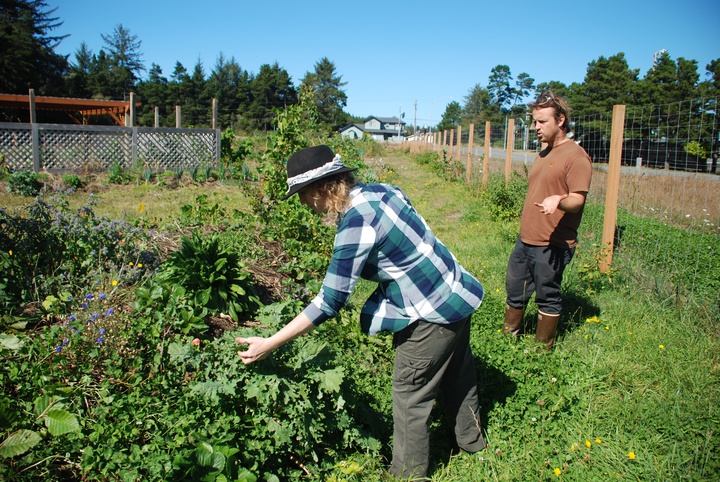Jessica Cejnar / Monday, Sept. 23, 2019 @ 5:34 p.m. / Community, Environment, Health, Our Culture
Play In the Garden: Harvest Festival Celebrates Grand Opening of Crescent City Food Forest

Angela Gray and Ben Zumeta prepare the Crescent City Food Forest for its grand opening. Photo: Jessica Cejnar
Before he and Angela Gray began separating strawberry plants Monday, Ben Zumeta surveyed a site that just two years ago had been barren.
Wandering among hugelkultur beds abundant with Swiss chard, kale, runner beans, daikon radish and wildflowers near College of the Redwoods Del Norte, Zumeta described how he and members of the Youth Training Academy introduced nitrogen and phosphorous back into the soil using cords of wood. Drawing on inspiration from the Aztecs, who grew crops on lake beds using artificial islands, Zumeta said the hugelkultur beds and French drains allow the Taa-‘at-dvn Chee-ne’ Tetlh-tvm, the Crescent City Food Forest, to thrive despite being on a wetland.
“We’re producing between 100 and 150 pounds a week for the food pantry,” he said, referring to the Community Food Council’s Pacific Pantry, one of Crescent City’s food banks. “And that could be higher if we had more harvesters.”
After two to three years of work, the Community Food Council is ready to welcome residents to the Crescent City Food Forest for a harvest festival on Saturday. The festival will include a barbecue, music, cooking demonstrations and food tastings, worm composting, arts and crafts, a raffle and apple pressing. There will also be a scavenger hunt and a petting zoo, according to an organization press release.
Located at College of the Redwoods’ Del Norte campus, the Crescent City Food Forest is one of four the Food Council and Tolowa Dee-ni’ Nation established through a Community Food Project grant from the USDA’s National Institute of Food and Agriculture. The Srtaa~Shvm (hii) Mvlh Ghee-saa-ghit-na’, or Good Food Makes Us All Healthy Project, also includes several community and school gardens throughout Del Norte County and adjacent tribal lands, according to the Food Council.
Other food forests are at the Early Learning program in Smith River, Margaret Keating Elementary School in Klamath and Saint’s Rest Community Garden in Weitchpec.
A food forest mimics the nature and productivity of a forest ecosystem, Zumeta said. Such a system has nine different layers including a canopy, an understory, shrubs and vines, ground covers and fungi. A food forest would yield root crops. And, in the Pacific Northwest, would generally be tied to a salmon stream, Zumeta said.
Through that stacking function, a gardener can get a diversity of yields, Zumeta said. If one thing doesn’t grow well, something else will be producing, he said.
Currently, the Crescent City Food Forest is producing squash and cucumbers in addition to the greens, daikon radish and runner beans, Zumeta said. When they get big enough trees will provide fruit as well as shelter from the wind. There are also strawberries, which will likely last through November.
“They usually start in April,” Zumeta said. “We get a month on either end of the season with strawberries on the hugelkultur beds.”
Roughly 90 species at the Crescent City Food Forest are edible, Zumeta said. There are dozens more wildflowers and other plants attractive to pollinators. When he began working on the food forest, Zumeta said, the only birds it attracted were crows. Now he’s seen hummingbirds, American gold finches and other songbirds.
The grand opening of the Crescent City Food Forest also coincides with Climate Justice Action Week in Del Norte. Zumeta noted that by using woody debris to build the hugelkultur beds and create the French drains, the Food Council has also incorporated an effective way to store carbon in the soil.
“On a conservative estimate we’ve put about 50 cords of wood into our hugelkultur beds,” Zumeta said. “Most people can heat two cords of wood, that’s about 35 years worth of heating output fo ra home that we’ve offset by putting it into the ground.”
The main goal of the Crescent City Food Forest is to show people how they can use hugelkultur beds and other permaculture practices to easily grow their own food, Zumeta said.
At the harvest festival on Saturday, Zumeta will lead tours of the food forest. He said there will also be orientations planned later on to show folks how they can contribute to the productivity of the forest. A hugelkultur garden club also meets from 2 p.m.-5 p.m. each Monday, Zumeta said.
Zumeta said he’s also hoping the community of Klamath will help with the Au Minot Food Forest at Margaret Keating.
“I think logistical things is what I’m really open to community input on,” he said. “I think we need somebody who we can compensate — we have a certain amount in the budget — to help manage the site. Ideally it would be somebody who already volunteers or works at the school.”
As for the harvest festival in Crescent City, folks should wear sturdy shoes and look forward to getting their hands dirty, Zumeta said.
“We’re going to try to make this as hands-on as possible to give people a feel that this is their community garden,” he said.
The Harvest Fest will be held from 1 p.m.-5 p.m. Saturday at the Crescent City Food Forest at College of the Redwoods Del Norte campus, West Washington Boulevard and Arlington Drive. A barbecue with two sides will be $3. Bring apples for pressing and containers for juice. For more information, email foodcouncildnatl@gmail.com or call (707) 464-0955 extension 2109.
CLICK TO MANAGE